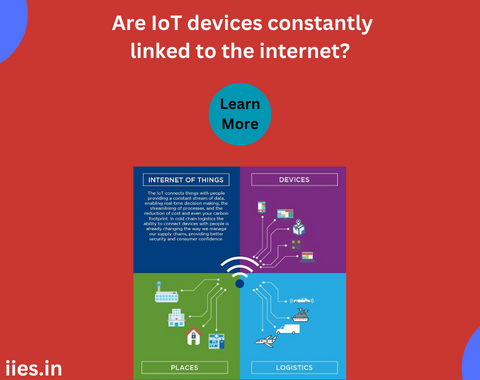
The Internet of Things (IoT) has revolutionized the way we interact with technology, seamlessly integrating devices into our daily lives. From smart thermostats to fitness trackers, IoT devices have become ubiquitous. However, a common misconception persists that these devices are always connected to the internet. In this article, we will explore the reality behind the myth and examine the factors that influence the connectivity of IoT devices.
The fundamental concept of IoT involves connecting devices to the internet to exchange data and provide enhanced functionalities. While connectivity is a defining feature of IoT, it doesn’t mean that all devices are constantly online. The connectivity of IoT devices can vary based on several factors, and understanding these nuances is crucial for a comprehensive perspective.
Communication Protocols:
IoT devices use various communication protocols to connect to the internet. Some devices utilize Wi-Fi for high-speed connectivity, while others rely on cellular networks, Bluetooth, Zigbee, or other wireless technologies. The choice of communication protocol significantly influences the device’s connectivity and whether it is always online or not.
Power Consumption:
Power constraints play a pivotal role in determining the connectivity of IoT devices. Battery-powered devices, such as smart sensors or wearable gadgets, may not be always connected to preserve battery life. These devices often operate in a low-power mode and establish connections only when necessary, such as when collecting or transmitting data.
Intermittent Connectivity:
Many IoT devices operate in environments with intermittent or unreliable internet connectivity. In scenarios where Wi-Fi or cellular signals are weak, devices may experience temporary disconnections. However, these devices are designed to handle such situations by caching data locally and synchronizing with the cloud once a connection is reestablished.
Edge Computing:
Edge computing is a paradigm where data processing occurs closer to the source (device) rather than relying solely on centralized cloud servers. Some IoT devices leverage edge computing to process data locally, reducing the need for constant internet connectivity. This approach enhances efficiency and responsiveness while potentially decreasing reliance on continuous online access.
Security and Privacy Concerns:
Security and privacy considerations may also influence the connectivity of IoT devices. Some devices disconnect from the internet when not actively transmitting data to mitigate the risk of unauthorized access or data breaches. This intermittent connectivity helps safeguard sensitive information stored on the devices.
User Preferences:
User preferences and device settings can impact IoT connectivity. Some devices allow users to control connectivity options, enabling them to decide when a device should connect to the internet. This flexibility is particularly relevant for devices like smart home appliances, where users may choose to disable internet access during certain periods.
Regulatory Compliance:
Regulatory requirements and standards can influence IoT connectivity. In certain industries, compliance mandates may dictate how and when devices can connect to the internet. This can result in devices being intentionally disconnected during specific operational phases or in certain geographic locations.
Environmental Considerations:
Environmental factors, such as extreme weather conditions or geographic remoteness, may affect IoT device connectivity. Devices deployed in remote locations or harsh environments may experience intermittent internet access, requiring them to adapt their connectivity accordingly.
Challenges and Opportunities in IoT Connectivity:
While the varied connectivity of IoT devices presents challenges, it also opens up new opportunities for innovation and optimization. Device manufacturers and developers constantly strive to strike the right balance between connectivity and other considerations to enhance the overall user experience and maximize the potential of IoT technologies.
Enhancing Power Efficiency:
Improving power efficiency is a key focus for IoT device developers. As the demand for longer battery life increases, advancements in low-power communication technologies and energy-efficient components contribute to making IoT devices more sustainable and user-friendly. Additionally, the integration of renewable energy sources and energy harvesting technologies can further extend the operational life of battery-powered devices.
Optimizing Data Transmission:
The intermittent connectivity of some IoT devices necessitates efficient data transmission strategies. Device developers are exploring ways to optimize data synchronization and ensure seamless communication when devices reconnect to the internet. This includes implementing intelligent algorithms that prioritize critical data transmission and minimize the impact of intermittent connectivity on the overall user experience.
Advancements in Edge Computing:
Edge computing plays a pivotal role in reshaping IoT connectivity dynamics. By processing data locally on the device or at the edge of the network, devices can reduce their reliance on constant internet connectivity. This not only enhances real-time responsiveness but also addresses concerns related to latency and bandwidth usage, particularly in applications like industrial IoT and autonomous systems.
User-Centric Customization:
Acknowledging that user preferences play a significant role in IoT device connectivity, manufacturers are increasingly incorporating customizable features. Devices that allow users to define connectivity schedules or choose specific modes of operation empower individuals to tailor their IoT experience according to their needs. This user-centric approach enhances the versatility and adaptability of IoT devices across diverse environments.
In conclusion, the notion that IoT devices are always connected to the internet is a misconception. The reality is more nuanced, with various factors influencing the connectivity patterns of these devices. Communication protocols, power considerations, intermittent connectivity, edge computing, security concerns, user preferences, regulatory compliance, and environmental factors all contribute to shaping how and when IoT devices connect to the internet.
As the IoT landscape continues to evolve, understanding the diverse connectivity profiles of these devices is crucial. Whether it’s for optimizing power consumption, ensuring data security, or complying with regulatory requirements, the ability of IoT devices to adapt their connectivity is a testament to their versatility in meeting the diverse needs of users and industries.
Indian Institute of Embedded Systems – IIES